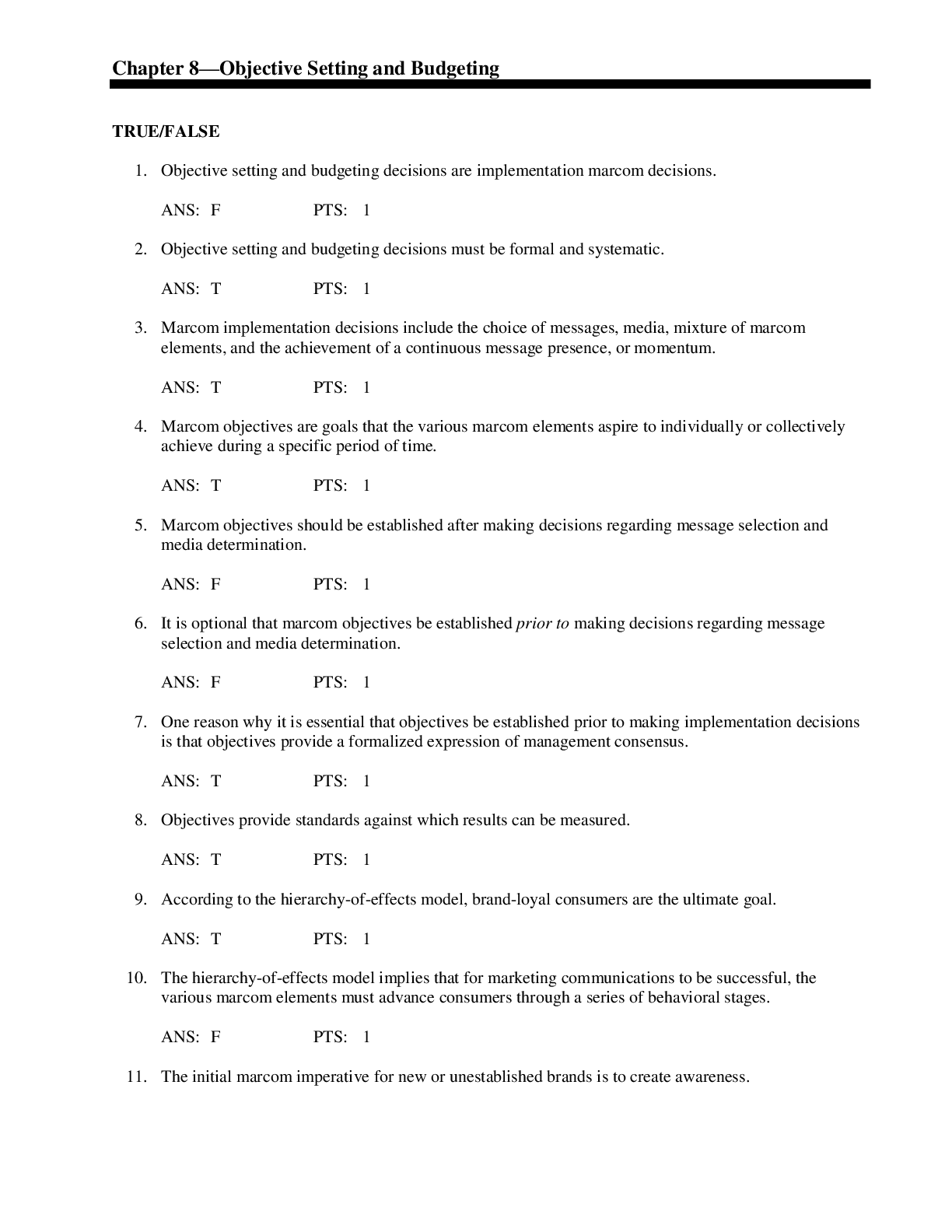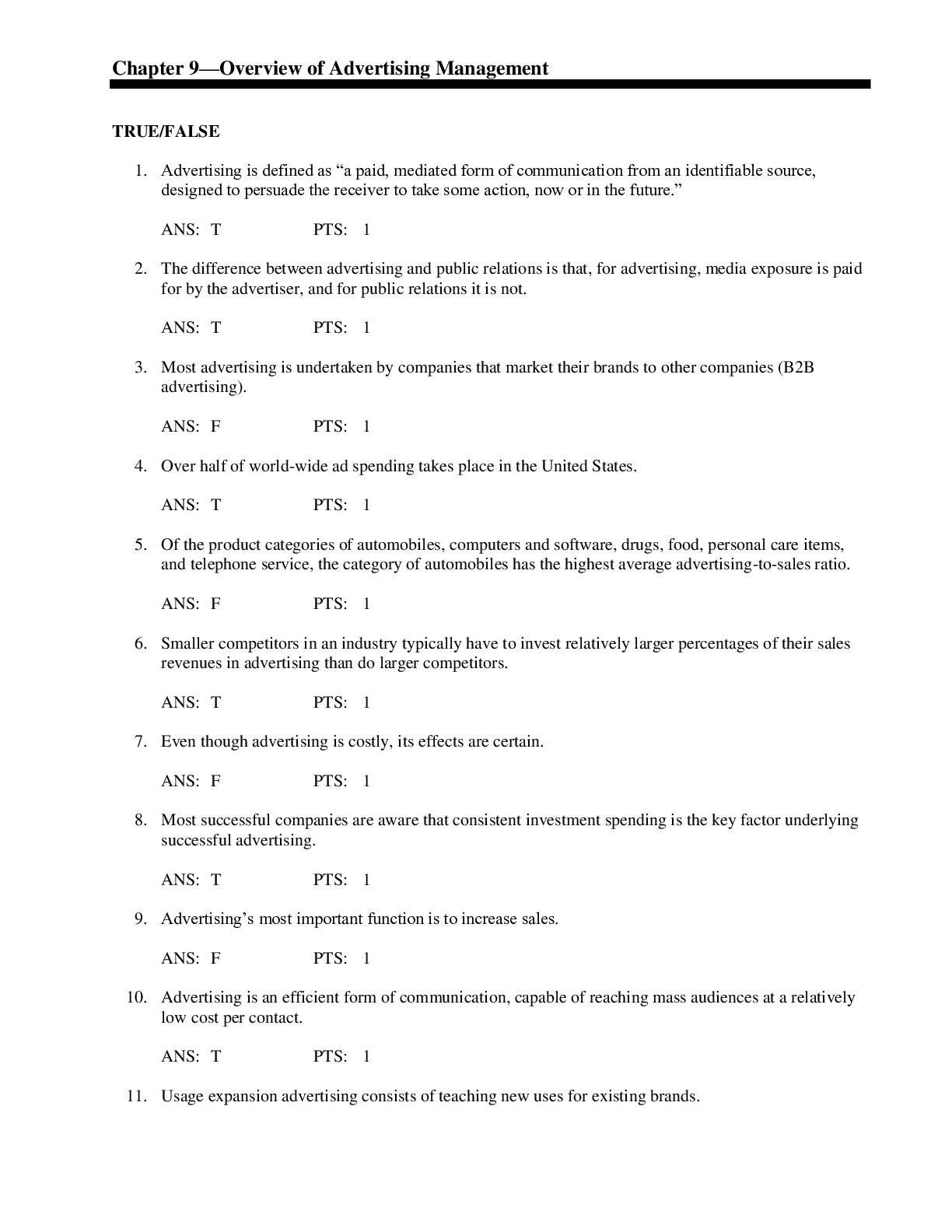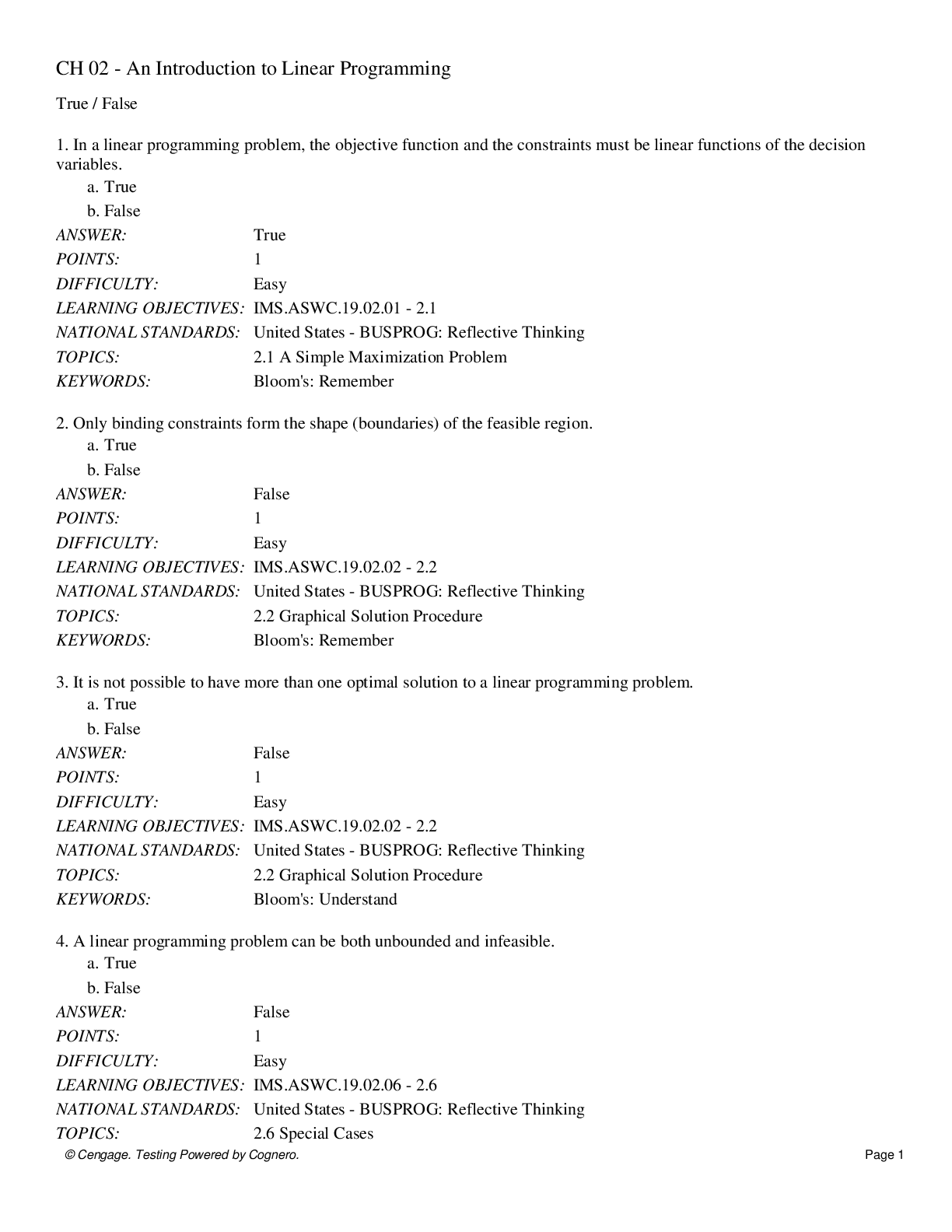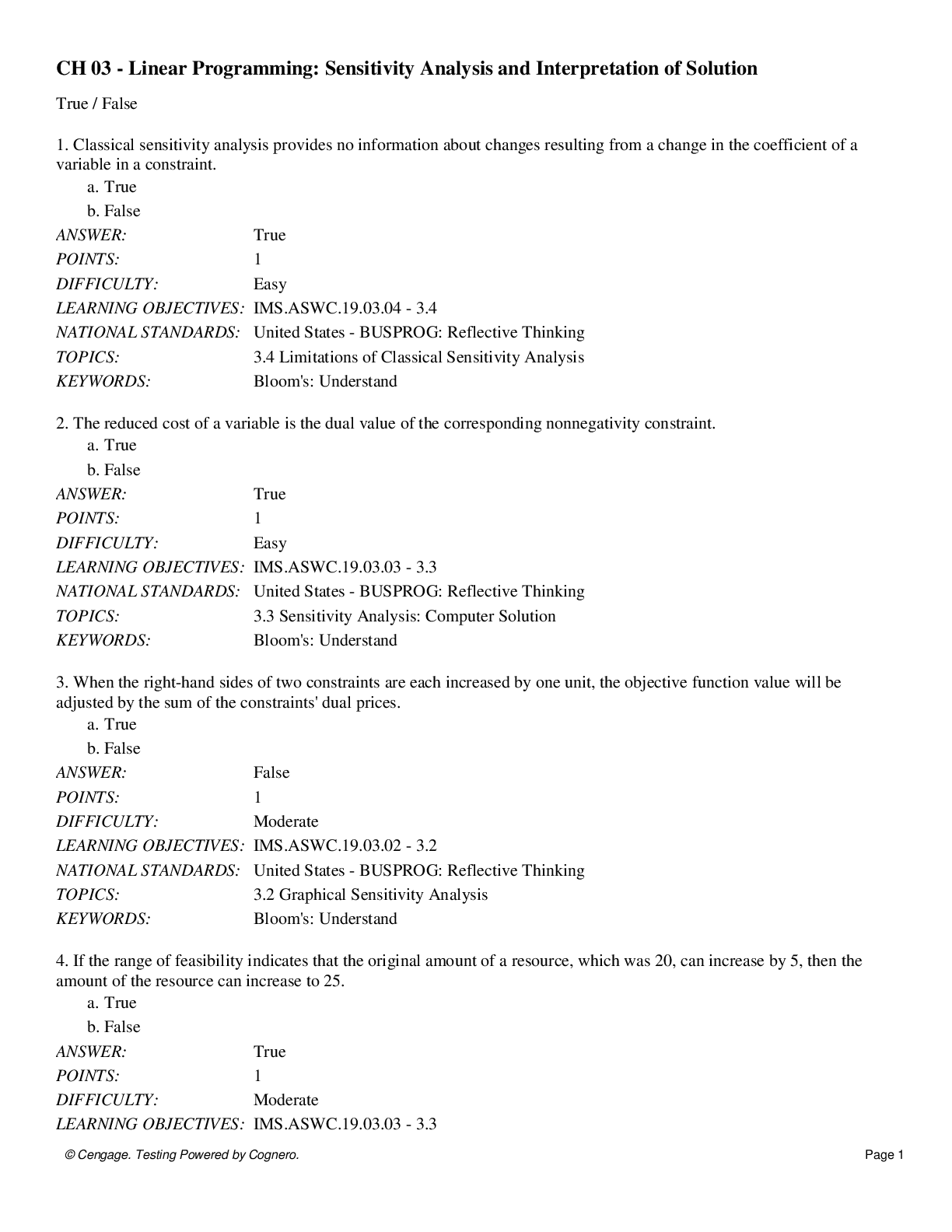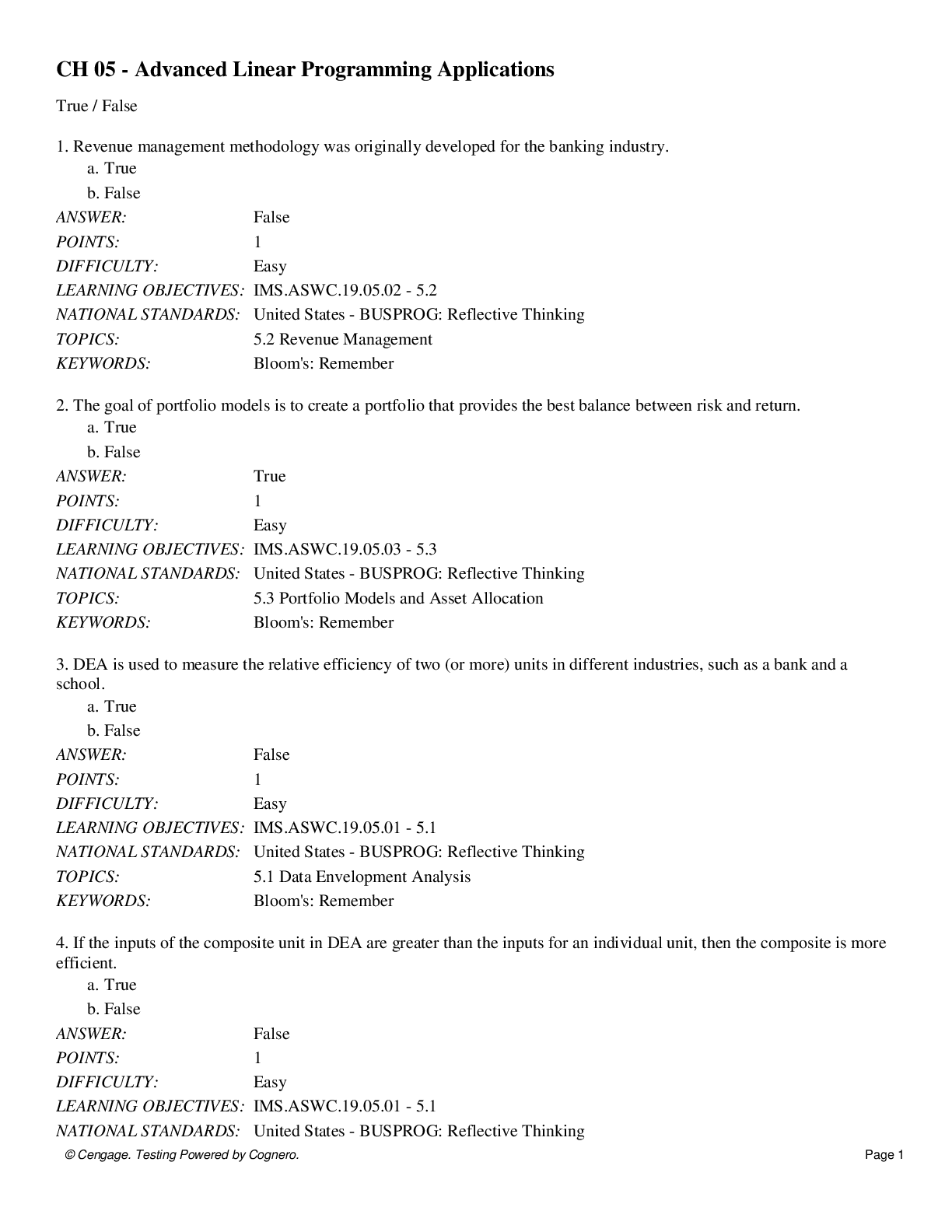Business Management > QUESTIONS & ANSWERS > Management Information Systems; Foundations of Business Intelligence: Databases and Information Mana (All)
Management Information Systems; Foundations of Business Intelligence: Databases and Information Management Questions and Answers Download to Score A+!!
Document Content and Description Below
1) Which of the following best illustrates the relationship between entities and attributes? A) The entity CUSTOMER with the attribute PRODUCT B) The entity CUSTOMER with the attribute PURCHASE C) ... The entity PRODUCT with the attribute PURCHASE D) The entity PRODUCT with the attribute CUSTOMER E) The entity PURCHASE with the attribute CUSTOMER Answer: B Difficulty: Challenging AACSB: Analytical thinking LO: 6-1: What are the problems of managing data resources in a traditional file environment? 2) All of the following are issues with the traditional file environment except: A) data inconsistency. B) inability to develop specialized applications for functional areas. C) lack of flexibility in creating ad-hoc reports. D) poor security. E) data sharing. Answer: B Difficulty: Challenging AACSB: Information technology LO: 6-1: What are the problems of managing data resources in a traditional file environment? 3) A characteristic or quality that describes a particular database entity is called a(n): A) field. B) tuple. C) key field. D) attribute. E) relationship. Answer: D Difficulty: Easy AACSB: Information technology LO: 6-1: What are the problems of managing data resources in a traditional file environment? 4) A ________ is an example of pre-digital data storage that is comparable to a database. A) library card catalog B) cash register receipt C) doctor's office invoice D) list of sales totals on a spreadsheet E) schedule of due dates on a project outline Answer: A Difficulty: Moderate AACSB: Analytical thinking LO: 6-1: What are the problems of managing data resources in a traditional file environment? 1 5) ________ creates confusion that hampers the creation of information systems that integrate data from different sources. A) Batch processing B) Data redundancy C) Data independence D) Online processing E) Data quality Answer: B Difficulty: Easy AACSB: Information technology LO: 6-1: What are the problems of managing data resources in a traditional file environment? 6) Data ________ occurs when the same data is duplicated in multiple files of a database. A) redundancy B) repetition C) independence D) partitions E) discrepancy Answer: A Difficulty: Easy AACSB: Information technology LO: 6-1: What are the problems of managing data resources in a traditional file environment? 7) Which of the following occurs when the same attribute in related data files has different values? A) Data redundancy B) Data duplication C) Data dependence D) Data discrepancy E) Data inconsistency Answer: E Difficulty: Challenging AACSB: Information technology LO: 6-1: What are the problems of managing data resources in a traditional file environment? 8) Which of the following is a grouping of characters into a word, a group of words, or a complete number? A) File B) Table C) Entity D) Field E) Tuple Answer: D Difficulty: Easy AACSB: Information technology LO: 6-1: What are the problems of managing data resources in a traditional file environment? 9) The fact that a traditional file system cannot respond to unanticipated information 2 requirements in a timely fashion is an example of which of the following issues with traditional file systems? A) Program-data dependence B) Lack of flexibility C) Poor security D) Lack of data sharing E) Data redundancy Answer: B Difficulty: Moderate AACSB: Information technology LO: 6-1: What are the problems of managing data resources in a traditional file environment? 10) A record is a characteristic or quality used to describe a particular entity. Answer: FALSE Difficulty: Easy AACSB: Information technology LO: 6-1: What are the problems of managing data resources in a traditional file environment? 11) Program-data dependence refers to the coupling of data stored in files and the specific programs required to update and maintain those files such that changes in programs require changes to the data. Answer: TRUE Difficulty: Moderate AACSB: Information technology LO: 6-1: What are the problems of managing data resources in a traditional file environment? 12) You have been asked to design a new contracts database for a small publishing company. What fields do you anticipate needing? Which of these fields might be in use in other databases used by the company? Answer: Author first name, author last name, author address, agent name and address, title of book, book ISBN, date of contract, amount of money, payment schedule, date contract ends. Other databases might be an author database (author names, address, and agent details), a book title database (title and ISBN of book), and financial database (payments made). Difficulty: Moderate AACSB: Analytical thinking LO: 6-1: What are the problems of managing data resources in a traditional file environment? 3 13) List at least three conditions that contribute to data redundancy and inconsistency. Answer: Data redundancy occurs when different divisions, functional areas, and groups in an organization independently collect the same piece of information. Because it is collected and maintained in so many different places, the same data item may have: 1. different meanings in different parts of the organization, 2. different names may be used for the same item, and 3. different descriptions for the same condition. In addition, the fields into which the data is gathered may have different field names, different attributes, or different constraints. Difficulty: Moderate AACSB: Analytical thinking LO: 6-1: What are the problems of managing data resources in a traditional file environment? 14) Which of the following enables a DBMS to reduce data redundancy and inconsistency? A) Ability to enforce referential integrity B) Ability to couple program and data C) Use of a data dictionary D) Ability to create two-dimensional tables E) Ability to minimize isolated files with repeated data Answer: E Difficulty: Challenging AACSB: Information technology LO: 6-2: What are the major capabilities of database management systems (DBMS) and why is a relational DBMS so powerful? 15) A DBMS makes the: A) physical database available for different logical views. B) relational database available for different logical views. C) physical database available for different analytic views. D) relational database available for different analytic views. E) logical database available for different analytic views. Answer: A Difficulty: Challenging AACSB: Information technology LO: 6-2: What are the major capabilities of database management systems (DBMS) and why is a relational DBMS so powerful? 4 16) The logical view of a database: A) displays the organization and structure of data on the physical storage media. B) includes a digital dashboard. C) allows the creation of supplementary reports. D) enables users to manipulate the logical structure of the database. E) presents data as they would be perceived by end users. Answer: E Difficulty: Moderate AACSB: Information technology LO: 6-2: What are the major capabilities of database management systems (DBMS) and why is a relational DBMS so powerful? 17) Which of the following is a DBMS for desktop computers? A) DB2 B) Oracle Database C) Microsoft SQL Server D) Microsoft Access E) Microsoft Exchange Answer: D Difficulty: Challenging AACSB: Information technology LO: 6-2: What are the major capabilities of database management systems (DBMS) and why is a relational DBMS so powerful? 18) A(n) ________ represent data as two-dimensional tables. A) non-relational DBMS B) mobile DBMS C) relational DBMS D) hierarchical DBMS E) object-oriented DBMS Answer: C Difficulty: Easy AACSB: Information technology LO: 6-2: What are the major capabilities of database management systems (DBMS) and why is a relational DBMS so powerful? 19) Microsoft SQL Server is a(n): A) DBMS for both desktops and mobile devices. B) Internet DBMS. C) desktop relational DBMS. D) DBMS for midrange computers. E) DBMS for mobile devices. Answer: D Difficulty: Challenging AACSB: Information technology LO: 6-2: What are the major capabilities of database management systems (DBMS) and why is a relational DBMS so powerful? 5 20) In a table for customers, the information about a single customer resides in a single: A) field. B) row. C) column. D) table. E) entity. Answer: B Difficulty: Easy AACSB: Information technology LO: 6-2: What are the major capabilities of database management systems (DBMS) and why is a relational DBMS so powerful? 21) In a relational database, a record is referred to in technical terms as a(n): A) tuple. B) table. C) entity. D) field. E) key. Answer: A Difficulty: Moderate AACSB: Information technology LO: 6-2: What are the major capabilities of database management systems (DBMS) and why is a relational DBMS so powerful? 22) A field identified in a table as holding the unique identifier of the table's records is called the: A) primary key. B) key field. C) primary field. D) unique ID. E) primary entity. Answer: A Difficulty: Moderate AACSB: Information technology LO: 6-2: What are the major capabilities of database management systems (DBMS) and why is a relational DBMS so powerful? 6 23) A field identified in a record as holding the unique identifier for that record is called the: A) primary key. B) key field. C) primary field. D) unique ID. E) key attribute. Answer: B Difficulty: Moderate AACSB: Information technology LO: 6-2: What are the major capabilities of database management systems (DBMS) and why is a relational DBMS so powerful? 24) In a relational database, the three basic operations used to develop useful sets of data are: A) select, project, and where. B) select, join, and where. C) select, project, and join. D) where, from, and join. E) where, find, and select. Answer: C Difficulty: Moderate AACSB: Information technology LO: 6-2: What are the major capabilities of database management systems (DBMS) and why is a relational DBMS so powerful? 25) The select operation: A) combines relational tables to provide the user with more information than is otherwise available. B) creates a subset consisting of columns in a table. C) identifies the table from which the columns will be selected. D) creates a subset consisting of all records in the file that meet stated criteria. E) creates a subset consisting of rows in a table. Answer: D Difficulty: Easy AACSB: Information technology LO: 6-2: What are the major capabilities of database management systems (DBMS) and why is a relational DBMS so powerful? 7 26) The join operation: A) combines relational tables to provide the user with more information than is otherwise available. B) identifies the table from which the columns will be selected. C) creates a subset consisting of columns in a table. D) organizes elements into segments. E) creates a subset consisting of rows in a table. Answer: A Difficulty: Easy AACSB: Information technology LO: 6-2: What are the major capabilities of database management systems (DBMS) and why is a relational DBMS so powerful? 27) The project operation: A) combines relational tables to provide the user with more information than is otherwise available. B) creates a subset consisting of columns in a table. C) organizes elements into segments. D) identifies the table from which the columns will be selected. E) creates a subset consisting of rows in a table. Answer: B Difficulty: Easy AACSB: Information technology LO: 6-2: What are the major capabilities of database management systems (DBMS) and why is a relational DBMS so powerful? 28) Microsoft Access's data dictionary displays all of the following information about a field except the: A) size of the field. B) format of the field. C) description of the field. D) type of the field. E) the organization within the organization that is responsible for maintaining the data. Answer: E Difficulty: Challenging AACSB: Information technology LO: 6-2: What are the major capabilities of database management systems (DBMS) and why is a relational DBMS so powerful? 8 29) Which of the following is an automated or manual file that stores information about data elements and data characteristics such as usage, physical representation, ownership, authorization, and security? A) Data dictionary B) Data definition diagram C) Entity-relationship diagram D) Relationship dictionary E) Data table Answer: A Difficulty: Moderate AACSB: Information technology LO: 6-2: What are the major capabilities of database management systems (DBMS) and why is a relational DBMS so powerful? 30) Which of the following is a specialized language that programmers use to add and change data in the database? A) Data access language B) Data manipulation language C) Structured query language D) Data definition language E) DBMS Answer: B Difficulty: Easy AACSB: Information technology LO: 6-2: What are the major capabilities of database management systems (DBMS) and why is a relational DBMS so powerful? 31) Which of the following is the most prominent data manipulation language today? A) Access B) DB2 C) SQL D) Crystal Reports E) NoSQL Answer: C Difficulty: Moderate AACSB: Information technology LO: 6-2: What are the major capabilities of database management systems (DBMS) and why is a relational DBMS so powerful? 9 32) DBMSs typically include report generating tools in order to: A) retrieve and display data. B) display data in an easier-to-read format. C) display data in graphs. D) perform predictive analysis. E) analyze the database's performance. Answer: B Difficulty: Moderate AACSB: Information technology LO: 6-2: What are the major capabilities of database management systems (DBMS) and why is a relational DBMS so powerful? 33) The process of streamlining data to minimize redundancy and awkward many-to-many relationships is called: A) normalization. B) data scrubbing. C) data cleansing. D) data defining. E) optimization. Answer: A Difficulty: Easy AACSB: Information technology LO: 6-2: What are the major capabilities of database management systems (DBMS) and why is a relational DBMS so powerful? 34) A schematic of the entire database that describes the relationships in a database is called a(n): A) data dictionary. B) intersection relationship diagram. C) entity-relationship diagram. D) data definition diagram. E) data analysis table. Answer: C Difficulty: Moderate AACSB: Information technology LO: 6-2: What are the major capabilities of database management systems (DBMS) and why is a relational DBMS so powerful [Show More]
Last updated: 1 year ago
Preview 1 out of 29 pages
Instant download

Buy this document to get the full access instantly
Instant Download Access after purchase
Add to cartInstant download
Reviews( 0 )
Document information
Connected school, study & course
About the document
Uploaded On
Jul 23, 2021
Number of pages
29
Written in
Additional information
This document has been written for:
Uploaded
Jul 23, 2021
Downloads
0
Views
79

.png)
.png)
.png)
.png)
.png)
.png)
.png)
.png)
.png)
.png)
.png)





